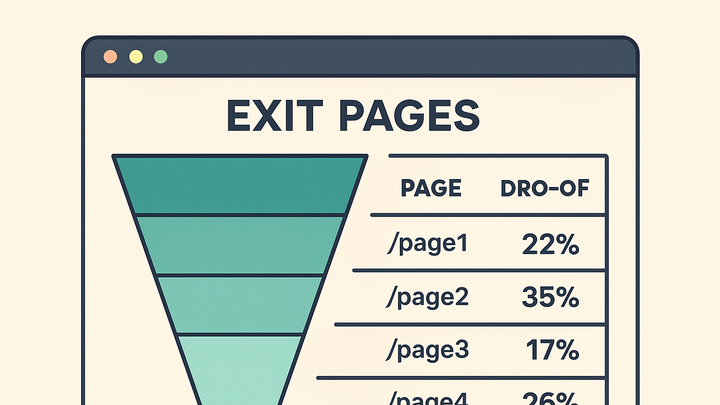Published on 2025-06-22T03:18:15Z
What is an Exit Page? Examples for Exit Pages
An Exit Page is the final page a user visits before leaving your site. It captures the last URL a visitor viewed before ending a session, offering insights into where and why users drop off. Unlike bounce rate, which measures single-page sessions, exit pages encompass multi-page journeys and pinpoint specific departure points. Analyzing exit pages helps identify underperforming content, broken links, or confusing navigation paths. Tools like PlainSignal and Google Analytics 4 automate exit tracking, allowing you to optimize page layouts, content flow, and calls-to-action. By monitoring exit pages over time, you can improve retention, guide users to conversion points, and enhance overall user experience. PlainSignal’s cookie-free approach respects user privacy while capturing essential exit data seamlessly.
Exit page
The final page a visitor sees before ending a web session, highlighting drop-off points to optimize site performance.
Definition of Exit Page
This section defines what an exit page is and how it differs from related metrics like bounce rate.
-
What is an exit page?
An exit page is the last URL or screen a visitor views before ending their session on your website or app.
-
Exit page vs bounce
A bounce occurs when a visitor leaves after viewing one page; an exit page can happen at the end of any session length.
Why Exit Pages Matter
Exit page analysis reveals where users commonly leave, helping to identify areas for improvement in the user experience and conversion funnel.
-
Identify drop-off points
High exit rates on certain pages highlight friction or dissatisfaction in the user journey.
-
Optimize conversion funnels
By adjusting content or calls-to-action on exit-prone pages, you can guide users towards desired outcomes.
-
Enhance content strategy
Understanding exit pages informs content planning to keep users engaged and reduce abandonment.
Tracking Exit Pages with PlainSignal and GA4
Implement exit page tracking using PlainSignal’s cookie-free script and Google Analytics 4’s enhanced measurement to capture exit data automatically.
-
PlainSignal setup
PlainSignal uses a single script to track page views and exits without cookies. Install the snippet on every page:
-
Installation code
<link rel="preconnect" href="//eu.plainsignal.com/" crossorigin /> <script defer data-do="yourwebsitedomain.com" data-id="0GQV1xmtzQQ" data-api="//eu.plainsignal.com" src="//cdn.plainsignal.com/plainsignal-min.js"></script> -
Automatic exit tracking
The script automatically logs the last visited page when a visitor navigates away or closes the browser.
-
-
GA4 configuration
Google Analytics 4 captures exit page data via enhanced measurement. To set up:
-
Enable enhanced measurement
In GA4 Admin > Data Streams, toggle on ‘Page views’ under Enhanced measurement.
-
Custom exit report
Use Explorations to create a report filtered by event name = page_view and dimension ‘Page path + query string’ with metric ‘Exits’.
-
Best Practices for Managing Exit Pages
Use exit page insights to reduce unwanted departures and improve overall site performance.
-
Refine page content
Ensure content aligns with visitor intent and addresses their needs before they leave.
-
Strategic calls-to-action
Place clear CTAs or next-step prompts on pages with high exits to guide users onward.
-
Implement exit-intent offers
Use exit-intent modals or popups to retain visitors with targeted offers or reminders.
-
A/b testing
Experiment with headlines, layouts, and CTA placement on exit-heavy pages to find what reduces exits.
